The Higher Road
I hadn’t met a single pilgrim on the road for three full days. Not that there weren’t any – I saw four people the very first day – but there weren’t many. For two nights in a row I was the only person staying in a pensión. The third morning I saw another place setting at breakfast, but I headed out before he or she came to the table. The only people I conversed with were hoteliers and hospitaleros, and barmaids at cafés along the way. I relished the solitude. Hours alone, just the sound of my footsteps and the swish-swish of my wet-weather pants. Nothing to do but walk and think and talk to myself out loud.
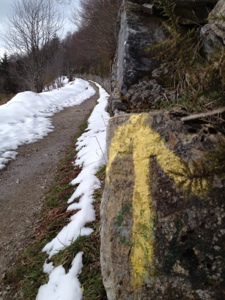
Except I’d catch myself thinking sour thoughts: remembering a difficult person, hashing over an unpleasant memory, or thinking about a conversation I’m not looking forward to. When I noticed this, I’d correct it, taking a deep breath of fresh air or focusing on the stunning vistas around me. I’d try to think about something good, like De-facto and Short-pants and Buddy-roo and how lucky I am that they would give me the space and time to do the Camino. Then, some kilometers later, I’d catch myself again, trudging through the bad stuff.
Why is that? Why is it that when my mind wanders, it meanders so easily to ugly thoughts? I’m not saying not to address or confront the difficult situations in life. But to fester with them, which I’m adept at, is really a waste of valuable mental capacity, not to mention that ever-precious commodity, time.
It makes me think about how important it is to pay attention to my train of thought, to be mindful of altering the ratio of “time spent thinking” in favor things positive and productive.
~ ~ ~
Coming out of Villafranca del Bierzo there are three routes, accordingly to the Brierley guidebook that I carry. The lower road snakes along the Route N-VI, passing through lots of little villages and hamlets. While easier on the knees – you don’t have to climb up and down any hills, or navigate rocky, muddy, or snowy trails – it’s not easy on the soul. You walk beside the cars and trucks, often sharing the road with them. It can also be dangerous; once when the path was merged with the road, I was in such a Camino zone I almost didn’t notice the oncoming car. 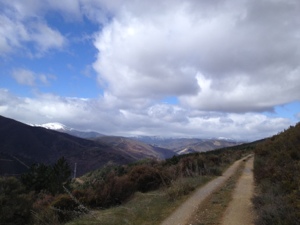
Another route is marked in the guidebook by a series of green dots, indicating an alternative scenic route, generally more forested and the furthest away from traffic. On these routes, you have to carry all your water and food. No counting on a village café to buy a bocadillo or have a bowl of caldo and you can’t be certain of finding potable water. This particular green-dotted route, called the Dragonte, is 25.1 kilometers of nature and no civilization, crossing three mountains, up and down. It would be gorgeous. It would also be rigorous. Given that ten days ago I was flat out with a bad back, and how tricky the weather might be, I knew I couldn’t risk it. Especially since hadn’t seen another pilgrim on the route since the first afternoon.
The third route, to the north, is called the Pradela. The guidebook warns of its steep incline, and suggests that it is a challenging path, but I couldn’t bring myself to take the route in the middle of the valley with all the traffic, which could be as dangerous, if not more, than being alone on a ridge in a forest by yourself for 13k, the distance until the first hamlet. I knew better than to take the uber-scenic trail. I didn’t want the low road. This one, the higher road, seemed just right.
It started out with an sharp, steep slope. For at least a hundred meters it felt like I was climbing a never-ending staircase. Eventually the slope became gentler, but it still headed upwards, taking me to and along a high ridge that peaked at 930 meters. I had sun and clouds that 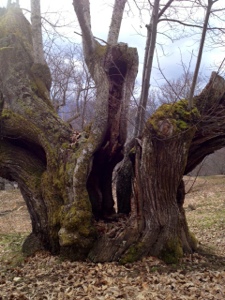 day, and lots of wind. I was high enough to have incredible views of the valley below and the mountains on the other side, with the trail I didn’t take. As the path gradually dipped back down toward the main road, it weaved through a forest of ancient chestnut trees with thick trunks and wise expressions. I was in the zone, like a runner’s high, so I stepped off the trail and wandered between the trees. I sat in the hollowed-out trunk of a grandfather chestnut tree, and thought about only good things.
day, and lots of wind. I was high enough to have incredible views of the valley below and the mountains on the other side, with the trail I didn’t take. As the path gradually dipped back down toward the main road, it weaved through a forest of ancient chestnut trees with thick trunks and wise expressions. I was in the zone, like a runner’s high, so I stepped off the trail and wandered between the trees. I sat in the hollowed-out trunk of a grandfather chestnut tree, and thought about only good things.
~ ~ ~
On the first day back on the Camino – now already a week ago – I came into a tiny village and saw a young woman walking out of a café-bar carrying a beer. She set it down on the table on the terrace. She said hello to me, in English, with an American accent.
“That’s a good idea,” I said, eyeing her beer. I unhooked myself from my backpack, setting it on the chair of a nearby table so I could go inside and get one, too.
“Maybe you can tell me,” she said, “how much should I tip here in Spain?”
“I don’t tip them at all,” a brash voice coming out of the bar answered before I had a chance. It belonged to a guy, probably in his early thirties, shaved head, a bit of a swashbuckler. I couldn’t tell his origin, maybe Brit, maybe Down Under. He set his glass on another table, across the road, but he didn’t sit down.
I explained to the young woman the my policy for tipping in Spain: rounding up to an even number and then adding a little bit more, especially now because the economy is in rough shape and these people are scraping by, especially in the winter with so few pilgrims on the route.
“They’d make some money if they weren’t all closed,” the guy yelled from across the street, pacing back and forth. “Think I can make it back to Astorga tonight? I’m gonna walk back and take a bus to Madrid where things are happening. I’m sick of this. Nothing is open.”
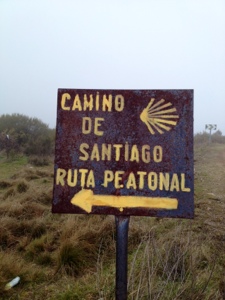
I wanted to ask him exactly why he’d started the Camino in the first place. But we were headed opposite directions and any suggestions I might make, soulful or reprimanding, probably wouldn’t register. I opted to keep quiet. Besides, it was my first day back on the Camino. Who was I to be a know-it-all? (At least out loud.)
It’s easy to be righteous. What’s harder is to let people be in their own place on their own path in their own problems. To observe, not in a scrutinizing or judgmental way, but in an observant and curious way, the kind where your silence might actually be more useful than your advice.
~ ~ ~
I lost track of the days of the week. I know the date, only because with every sello, or stamp, in my credentials, the barmaid or hospitalier is obliged to add the date. At first I tried to keep count of how many days to Santiago, but then I realized it involved keeping track of the time. While it may not be something I can do permanently, at least this week I can take a vacation from worrying about when and where I have to be next. So, it could take two more days, it could take four days, it depends on my feet, my back, the weather. I’ve walked in the pouring rain for two days now. It can make you walk faster. Or it can make you stop early for the day.
I’ve made good time, better than I expected, but not because I’ve been in a hurry. It happened more than once: I’d set off in the morning gauging where I might like to finish the day, thinking about a walk of 18-25k, targeting an albergue or a pensión marked in the guidebook. I’d get there, only to find everything shut tight. One day I walked 36k, passing through four villages that I hoped would have accommodation, but nothing was open. I found myself cursing them, out loud to nobody, for being closed. It made me think about that guy I met on the first day. I’m glad I didn’t say anything to him. I hope he’s having a good time in Madrid.
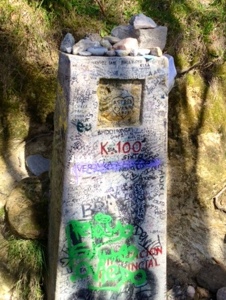
The minimum distance you must walk to qualify for a compostela is 100 kilometers. People who don’t want to walk the whole distance of the Camino, or who can’t take the time, will start in Sarria, 100 kilometers away, and walk the four or five days it takes to get to Santiago. In Sarria, the volume of pilgrims increases, noticeably. All of a sudden, the luxurious days of walking without seeing a soul are over. My solitude has been abruptly interrupted.
The first morning out of Sarria, I ducked into a roadside café to rest my feet for a few moments. After days of being the only person in just about every bar I stopped at, I was surprised to see tables crowded with pilgrims and a line to use the bathrooms. There was a buzz of conversation, and then the ritual of pilgrim questions: Where are you from? Where did you start? Why are you doing the Camino?
I wasn’t really in the mood for this chatter. I wanted to shout out: What are all you people doing on my Camino? I’ve done the whole Camino Francés, from the beginning, in St. Jean Pied de Port, and I’ve been walking for days, over high peaks and through a foot of snow!
But I didn’t. I’ve spent too much time walking, and thinking, about the higher roads, and how to take them. I softly answered the questions, and asked a few of my own, gently moving into the company and companionship of others, on their own paths but for the next few days, next to mine, as the road, high and low, draws us all nearer to Santiago.
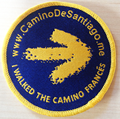
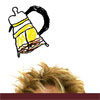
March 25th, 2013 at 12:13 am
Your story of the man on his way to Madrid is in tune with our experience yesterday… invited to the home of a friend who lives on a river in central Florida, the three of us set out in kayaks up the impossibly gorgeous water, shallow and calm, accompanied by tiny gators and orchids and hundreds of birds. So many shades of green. The river by her house is narrow, sometimes the three of us could barely kayak abreast.
But then we had to pull off to the side while a speedboat swished by, the couple riding it playing very loud country music, loud enough to drown out their engine sound, sort of. They gave us cheerful smiles and a thumbs up as they passed.
A great live-and-let-live moment.
March 25th, 2013 at 5:56 am
What I remembered as I read this: “Walk, just walk.”
I think you’re right. It’s important to be mindful of where our trains of thought take us. It’s as easy to be negative as it is to be a self-righteous know-it-all (out loud or quietly to ourselves).
I loved this: “What’s harder is to let people be in their own place on their own path in their own problems. To observe, not in a scrutinizing or judgmental way, but in an observant and curious way, the kind where your silence might actually be more useful than your advice.”
This is why I pray. It’s not because I want God to do anything for me. It’s because I want to be as present as I can to/in this life I’m leading filled as it is with bad things I dwell too much on, and good things I don’t spend enough time with…
I also liked the shouting you didn’t do, juxtaposed against the shouting the guy pacing across the street did. It’s both a nice parallel, and a sign of being in the Camino-zone. Both may also interesting to consider alongside the way you responded to the man in the green vest, last year.
March 25th, 2013 at 10:15 am
So beautifully written. The wisdom of the chestnut trees is a particularly moving image. The rootedness of our beings gets yanked around so much these days, it’s good to know that sitting inside a big old tree trunk can bring us comfort still. Glad you are finding it all. Walk well.
March 25th, 2013 at 4:15 pm
I can feel I am with you as you describe the wanderings of the mind (that’s what it does!), the peaceful and glorious surrounding, and the stillness you find in yourself along the way. Such a blessing for you to do the Camino, the balance between being one with many and being just who you are.
Love, Lee
March 25th, 2013 at 10:31 pm
After getting up to let the dog out in the middle of the night my whole body enjoyed the feeling of snooshing back into a warm bed knowing that there was lots of the night left to sleep. And then… nothing, except for the dredged up memories of all the embarrassing, stupid, thoughtless, moronic, childish, awkward, juvenile, failures I’ve had or things I’ve done. Around and around they went, one leading into another, into another. Everytime I started a new memory it deteriorated into something even more horrible and sleep stealing. I wish I knew why: anxiety, guilt, starting something new, fear of failure? I just wish they were more useful to me. On top of the failure I recall, now I have the failure of all that wasted time dwelling on the failure! What IS the purpose of it? When you come to end of the Camino I know you’ll know. And then you can tell us.
Walk in the light – kunyi